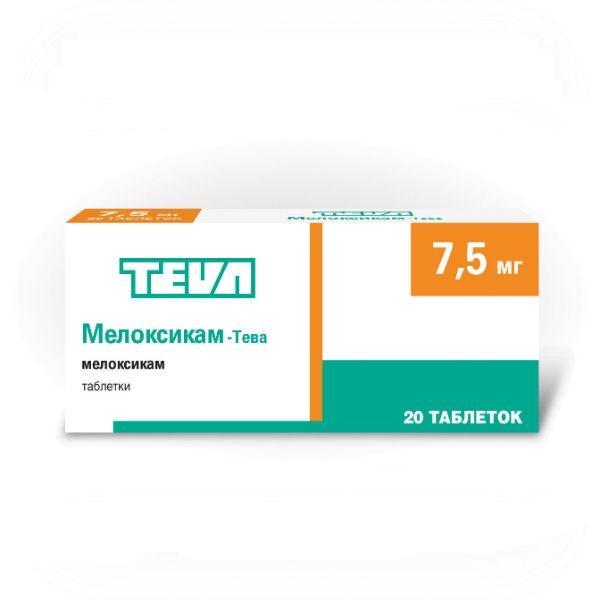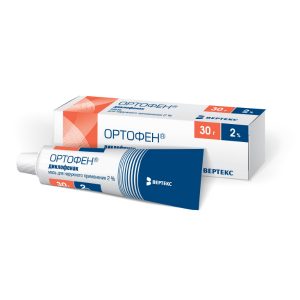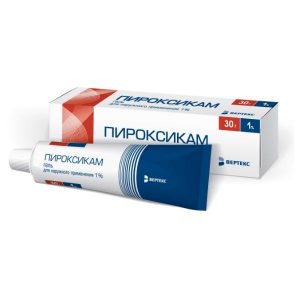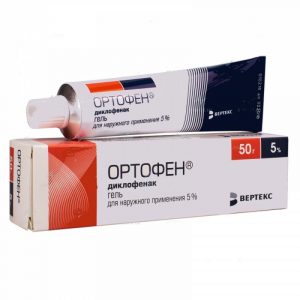Description
Release form
Tablets.
Packing
20 pcs.
Pharmacological action
Meloxicam has anti-inflammatory, analgesic, antipyretic effects.
Contraindications
Hypersensitivity (including other NSAIDs), the ² Ñaspirin ² Ñ triad (a combination of bronchial asthma, recurrent nasal polyposis and paranasal sinuses and intolerance of the acetylsalicylic acid and duodenal ulcer and pyrezole intestinal diseases) gastrointestinal cerebrovascular or other bleeding / hemorrhage severe heart failure, severe liver failure, severe renal failure (if hemodialysis is not performed), pregnancy, breast-feeding, up to 15 years of age.
Use during pregnancy and lactation
Teratogenic effects. Meloxicam increased the frequency of cardiac septal defects (a rare complication) when using an oral dose of 60 mg / kg / day (64.5 times the dose of 15 mg / day for an adult weighing 50 kg in terms of body surface area) and embryo-lethality with oral doses 5 mg / kg / day (5.4 times the dose for humans, as described above) in rabbits receiving meloxicam during organogenesis. Meloxicam did not show teratogenicity in rats at oral doses of 4 mg / kg / day (about 2.2 times the dose for humans, as described above) during organogenesis. An increase in the stillbirth rate was observed in rats with oral doses of 1 mg / kg / day during organogenesis.
Non-teratogenic effects. Meloxicam caused a decrease in indicators such as the birth rate, live birth, neonatal survival at oral doses of 0.125 mg / kg / day (approximately 0.07 times the dose for humans, as described above) in rats during pregnancy and lactation.
Meloxicam crosses the placental barrier. Adequate and strictly controlled studies in pregnant women have not been conducted. Use during pregnancy is possible if the expected effect of therapy exceeds the potential risk to the fetus.
No studies have been conducted to evaluate the effect of meloxicam on closure of the ductus arteriosus in humans. The use of meloxicam in the third trimester of pregnancy should be excluded.
Childbirth and delivery. In studies in rats, it was shown that meloxicam, like other agents that inhibit the synthesis of PG, increases the number of stillbirths, causes a delay in childbirth and delivery at oral doses of 1 mg / kg / day (about 0.5 times the dose for humans, as described above) and reduces the number of surviving cubs with oral doses of 4 mg / kg / day (about 2.1 times the dose for humans, as described above) during organogenesis. Similar observations were observed in rats receiving oral doses of 0.125 mg / kg / day (approximately 0, 07 times the dose for humans, as described above) during pregnancy and lactation.
The effects of meloxicam on childbirth and delivery in humans are unknown.
FDA category of action for the fetus is C.
The use of meloxicam, as well as other drugs that block the synthesis of PG, can affect fertility, therefore it is not recommended for women who want to become pregnant.
Meloxicam is excreted in milk of lactating rats, while the concentration in milk exceeds the concentration in plasma. It is not known whether meloxicam passes into breast milk of women, therefore, breast-feeding should be discontinued during treatment or the use of meloxicam during breast-feeding should be avoided.
Special instructions
Used with caution in cases of upper gastrointestinal diseases in history, in combination with anticoagulants, myelotoxic drugs, incl. methotrexate (possible cytopenia). The occurrence of gastroduodenal ulcers, gastrointestinal bleeding, side effects from the skin and mucous membranes serves as the basis for drug withdrawal. If during the treatment process allergic reactions (itching, skin rash, urticaria, photosensitization) occur, you should consult a doctor to resolve the issue of stopping the drug. The risk of gastrointestinal complications. Serious side effects from the gastrointestinal tract, including inflammation, bleeding, ulceration and perforation of the stomach or intestines, can occur at any time with NSAIDs without warning signs. Elderly patients have a higher risk of serious complications from the gastrointestinal tract, the likelihood of these complications also increases with prolonged use. Meloxicam, like other NSAIDs, can mask the symptoms of infectious diseases. The administration of NSAIDs to patients with reduced renal blood flow and BCC can accelerate renal decompensation (after discontinuation of NSAID therapy, kidney function usually returns to its previous level). The risk of developing such reactions is especially high in patients with dehydration, congestive heart failure, liver cirrhosis, nephrotic syndrome and severe kidney disease, in patients receiving diuretics, as well as in those who underwent significant surgery that led to hypovolemia (careful monitoring is necessary from the beginning of treatment diuresis and kidney function). In rare cases, NSAIDs can cause interstitial nephritis, glomerulonephritis, kidney necrosis of the brain or nephrotic syndrome. With a significant deviation from the normal level of serum transaminases and other indicators characterizing liver function, stop taking and carry out control laboratory tests. Precautions are prescribed for the elderly, weakened and emaciated patients. The use of meloxicam can cause the appearance of undesirable effects such as headache and dizziness, drowsiness. In this regard, you should abandon driving, servicing machinery and other activities that require increased concentration of attention.
Composition
1 tablet contains meloxicam 7.5 mg.
Dosage and administration of
meloxicam is taken orally. The dose is selected individually, it is necessary to use the lowest effective dose for a minimum period of time. Inside, with food, without chewing, at a dose of 7.5-15 mg once a day. The maximum daily dose is 15 mg, in patients with severe renal failure on hemodialysis – 7.5 mg. With a slight or moderate decrease in renal function (creatinine clearance> 25 ml / min), as well as with cirrhosis in a stable clinical state, dose adjustment is not required. The initial dose in patients with an increased risk of side effects is 7.5 mg / day.
Side effects
Frequency: often – more than 1% infrequently – 0.1-1% rarely – 0.01-0. 1% is very rare – less than 0.01%.
From the digestive system: often – dyspepsia, incl. nausea, vomiting, abdominal pain, constipation, flatulence, diarrhea infrequently – a transient increase in hepatic transaminase activity, hyperbilirubinemia, belching, esophagitis, gastroduodenal ulcer, gastrointestinal bleeding (including hidden), stomatitis rarely – gastrointestinal perforation, colitis, gastritis.
From the side of hematopoietic organs: often – anemia infrequently – a change in the blood formula, incl. leukopenia, thromocytopenia.
From the skin: often – itching, rash infrequently – urticaria rarely – photosensitivity, bullous rashes, erythema multiforme, incl. Stevens-Johnson syndrome, toxic epidermal necrolysis.
From the respiratory system: rarely – bronchospasm.
From the nervous system: often – dizziness, headache infrequently – vertigo, tinnitus, drowsiness rarely – confusion, disorientation, emotional lability.
From the CCC side: often – peripheral edema infrequently – increased blood pressure, palpitations, flushing of the face.
From the urinary system: infrequently – hypercreatininemia and / or an increase in the concentration of urea in the blood serum rarely – acute renal failure, no connection with meloxicam has been established – interstitial nephritis, albuminuria, hematuria.
On the part of the sensory organs: rarely – conjunctivitis, visual impairment, including blurred visual perception.
Allergic reactions: rarely – angioedema, anaphylactoid / anaphylactic reactions.
Drug Interactions
When used simultaneously with acetylsalicylic acid and other NSAIDs, the risk of erosive and ulcerative lesions and bleeding from the gastrointestinal tract increases. With simultaneous use with antihypertensive drugs, a decrease in the effectiveness of the action of the latter is possible. With simultaneous use with lithium preparations, cumulation of lithium and an increase in its toxic effect are possible (it is recommended to control the concentration of lithium in the blood). The simultaneous use of methotrexate enhances the side effect of the latter on the hematopoietic system (there is a risk of developing anemia and leukopenia. Periodic monitoring of the general blood test is necessary). Joint use with diuretics and cyclosporine leads to an increased risk of developing renal failure. With simultaneous use with intrauterine contraceptives, the effectiveness of the latter may decrease. With simultaneous use with anticoagulants (heparin, ticlopidine, warfarin), as well as with thrombolytic drugs (streptokinase, fibrinolysin), the risk of bleeding increases (blood clotting indicators should be periodically monitored). Simultaneous use with colestyramine enhances the excretion of meloxicam through the gastrointestinal tract (as a result of meloxicam binding). With the simultaneous administration of meloxicam with antacids, pharmacokinetic interaction was not found.
Overdose
Symptoms: increased side effects.
Treatment: gastric lavage, activated charcoal intake (within the next hour), symptomatic therapy. Cholestyramine accelerates the elimination of the drug from the body. Forced diuresis, urinary alkalinity, hemodialysis are ineffective due to the high association of meloxicam with blood proteins. No specific antidotes and antagonists were detected.
Storage Conditions
The product should be stored in a dry, dark place at a temperature not exceeding 25 ° C.
Shelf life
3 years.
Deystvuyushtee substance
Meloxicam
dosage form
tablets
Possible product names
meloxicam tab. 7.5 mg N20 Hungary
MELOXICAM-TEVA 0.0075 N20 TABLE
Meloxicam-Teva tablets 7.5 mg 20 pcs.
Meloxicam-Teva tablets 7.5 mg, 20 pcs.
Teva Pharmaceutical Enterprise Co., Ltd., Israel




